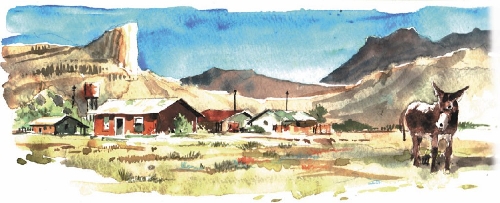Calico Early Man Site an intriguing, educational place
The Calico Early Man Site near Barstow, Calif., continues to intrigue visitors and confound conventional scientific theories about early man in North America. Thousands of primitive artifacts unearthed there predate other sites by thousands of years, thereby becoming controversial. Visitors see some of the artifacts at the small center before they start a guided tour of the site. Often visitors watch volunteers continuing their careful work at the archaeological dig.
The Calico Early Man Site lies a couple of miles west of Interstate 15 about 160 miles south of Las Vegas. Exit I-15 at the Minneola off-ramp about 15 miles north of Barstow. Follow signs along a gravel road to the site where the road ends in a graded parking lot near a small project building and restrooms. The building serves as visitor center, display room, gift shop and tour assembly area.
Open five days a week all year, the site lies on desert administered by the Bureau of Land Management. It remains open through the efforts of a volunteer support group, the Friends of the Calico Early Man Site, which schedules a manager/guide to be on hand Wednesdays through Sundays. Hugo Christiansen meets visitors on Wednesdays from about noon to 4:30 p.m., and Thursdays through Sundays from 8 a.m. to 4:30 p.m. Christiansen guides tour groups Wednesdays at 1:30 and 3:30 p.m., and Thursdays through Sundays at 9:30 a.m., 11:30 a.m., 1:30 p.m. and 3:30 p.m. Expect to pay a small fee -- $5 for adults, $3 for seniors aged 62 and over and $1 for children aged 12 and younger.
Visitors listen to an expert introduction before following the sometimes steep path to the main excavation area near the top of a rocky hill. Count on spending at least an hour on the tour, partly in full sun. Wear sturdy footgear, use sunblock, protect your face and head with a hat and carry bottled water.
The Friends of the Calico Early Man Site organization provides opportunities for amateur archaeologists to get their hands dirty at a real dig and to further the scientific exploration of the site. Work sessions organized free of charge by the group continue into early May this season. Volunteer excavators learn about digging techniques, recording finds, distinguishing artifacts from natural stones and maintaining the site. They hear informal lectures on geology, astrology, early humans, skills such as flint-knapping and related topics. Check the group's website at www.meetup.com/Friends-of-Calico-Early-Man-Site/.
To make sense of the site, visitors must visualize the Mojave Desert of today when it was well-watered and verdant long ago. Ancient Lake Manix lay full of fish, its surface dotted with waterfowl. Lush plains teeming with game surrounded the water, attracting many predators, including early human hunters.
Many scientists working at the site since its discovery by amateur archaeologists in 1942 believe the spot became a work site for hunters shaping stone tools, perhaps seasonally occupied. The early flint-knappers used stone washed out of the mountains toward the lake. Over time, the ancient alluvial fan solidified into rock layers where the volunteers work in trenches today to find rock cores, broken points and stone chips trapped in the sediment of ages past.
An early San Bernardino County archaeologist, Ruth Dee Simpson, took samples of the site's artifacts to London in 1954 to show them to famed archaeologist Louis S.B. Leakey, discoverer of early man sites in Africa's Olduvai Gorge.
Leakey arranged financing through the National Geographic Society, visited the Calico site in 1964 and became its project director until his death in 1972. Involved at the site until her death in 2000, Simpson spent decades there.
If enough evidence from the site substantiates its reality, the site would be the earliest yet found in the Western Hemisphere. Therein lies the rub, for the evidence suggests a date which is improbably early -- between 135,000 and 200,000 years ago. Dissenting scientists also point out that to date no human remains have been found at the site -- no bones, no teeth, no fossilized excrement. Archaeological team members continue to remove debris with dental picks and bristle brushes, hoping still for evidence that proves beyond the doubt the importance of the Calico Early Man Site.
Margo Bartlett Pesek's column appears on Sundays.






















